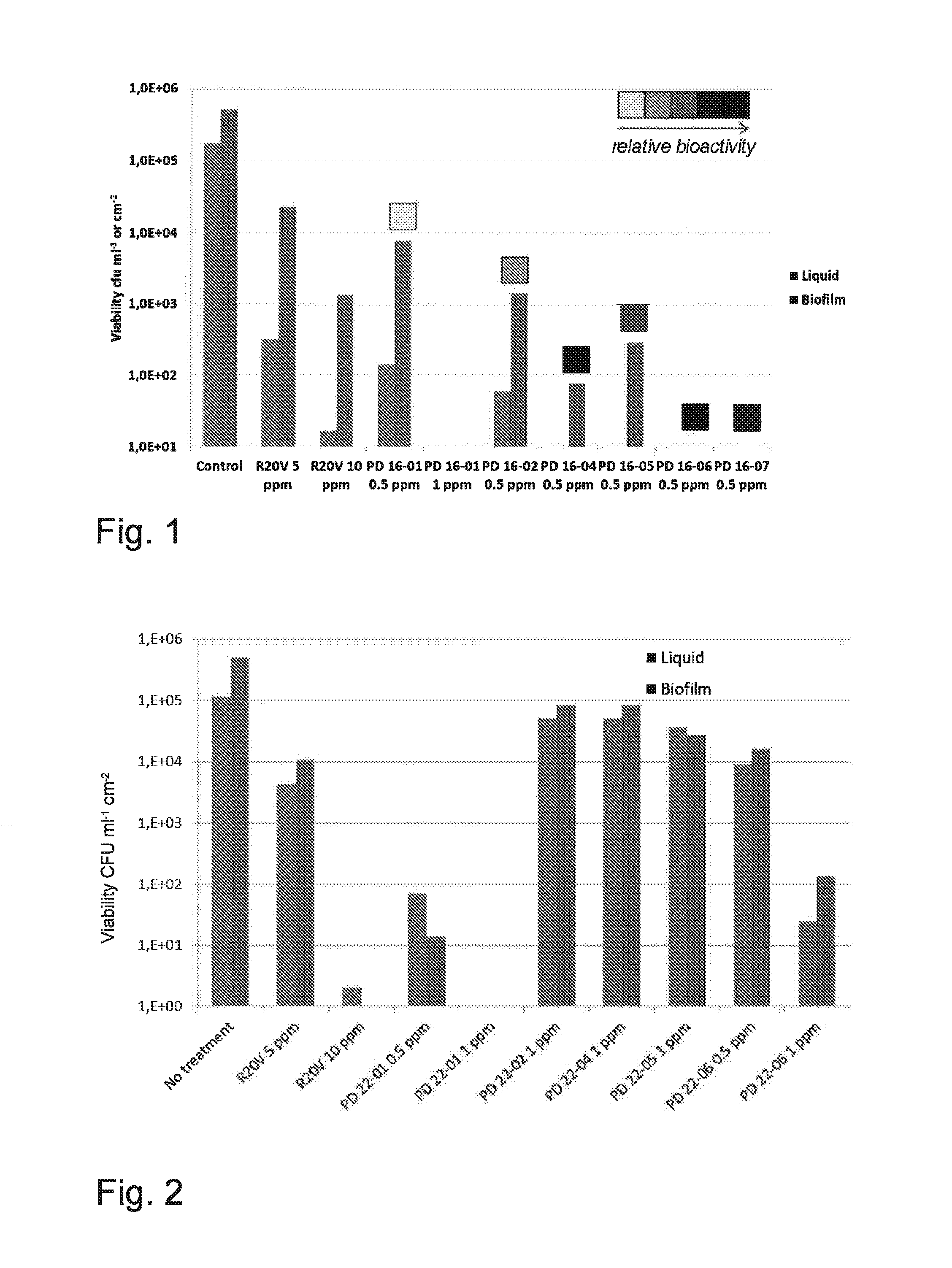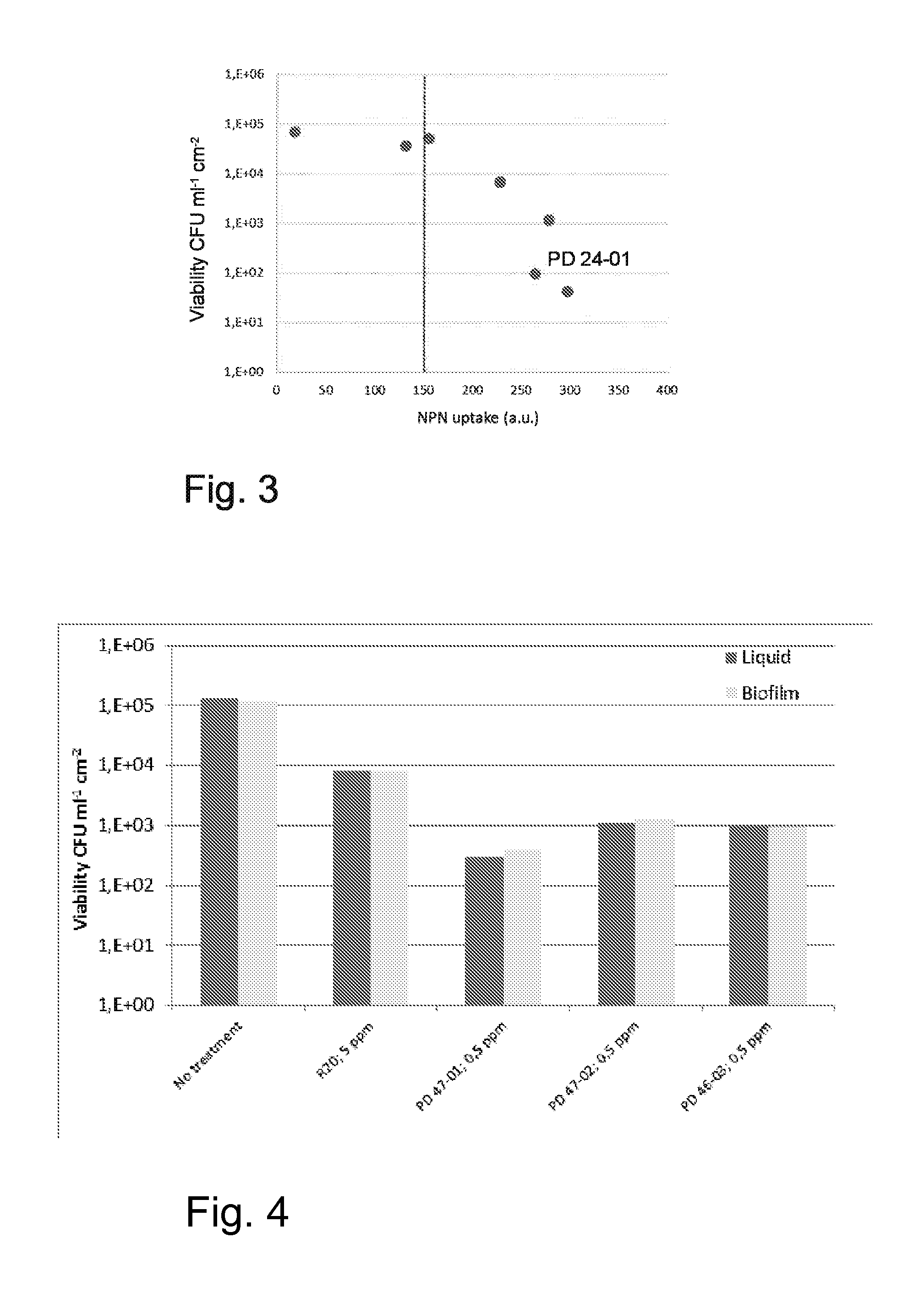Biocide formulation and method for treating water
a biocide and water treatment technology, applied in biocide, water treatment compounds, specific water treatment objectives, etc., can solve the problems of high energy consumption, unscheduled machinery downtime, poor heat transfer, etc., and achieve the effect of reducing the cut-off dosage value, reducing the cost of formulation, and reducing the viability of planktonic and biofilm cells
- Summary
- Abstract
- Description
- Claims
- Application Information
AI Technical Summary
Benefits of technology
Problems solved by technology
Method used
Image
Examples
example 1
Comparison of Different Biocide Compositions
[0072]This study was performed for comparing the biocidal performance of different biocidal compositions against bacterial cells in biofilm and in liquid. The reference biocide was a commercial DBNPA-containing product (R20V). It was compared to different novel formulations, all having DBNPA as the biocidal active agent in them. All dosages are shown as the dosage of biocidal active agent DBNPA (mg / l, ppm). The biofilm test was executed as explained above. Results in FIG. 1 show that 10 ppm of DBNPA showed good killing efficacy of planktonic cells when dosed in the form of R20V product (=free DBNPA). However, at this dosage the efficacy against biofilm was not as strong. The novel micellar formulations (PD16-01 to PD16-07) started to show a strong effect against planktonic and biofilm cells already at dosage level of 1 ppm or less (ppm's on basis of the DBNPA content). The novel formulations were thus capable of improving biofilm control p...
example 2
Comparison of Different Biocide Compositions
[0073]This study was performed for two reasons. Firstly, to evaluate the impact of PEI addition on the performance of the novel biocide formulations. Secondly, mixtures were prepared to evaluate the relative impact of different components. The compositions are shown in Table 1.
TABLE 1Sample series PD-22.SampleFennosanPluronicMilli-Q waterBardac-22“Name” of thecodeR20F68(+citric acid)DBNPA(50% DDAC)Retaminolcomposition:PD22-011.88 g3.07 g2.5 g2.25 g0.3 gGMC(18.8%)(30.7%)(25%)(25%)(3%)PD22-021.88 g8.12 gPluronic(18.8%)(81.2%)PD22-035.25 g2.5 g2.25 gDDAC + DBNPA (1(52.5%)(25%)(22.5%)PD22-04 9.7 g0.3 gPEI(97%)(3%)PD22-051.88 g5.87 g2.25 gDDAC + Pluronic(18.8%)(58.7%)(22.5%)PD22-067.75 g2.25 gR20 + DDAC(77.5%)(22.5%)(1 Incomplete solubilization of DBNPA when mixed with DDAC was observed and it was excluded from the biofilm test.
[0074]The biofilm test was executed as explained above. Results in FIG. 2 show that 5 ppm of DBNPA had very weak killi...
example 3
Permeabilization Study
[0076]Biofilm killing / inactivation tests were conducted with micellar Pluronic+DBNPA formulations, all with 9% DBNPA content, but with a varying DDAC content. The killing efficacy was measured. In addition, a membrane permeabilization study was executed with the known “NPN uptake method” (Hancock & Wong. AAC. Vol. 26, No. 1:48-52. July, 1984; Alakomi et al., Weakening Effect of Cell Permeabilizers on Gram-Negative Bacteria Causing Biodeterioration, Appl Environ Microbiol. 2006 July; 72(7): 4695-4703) using cells of Pseudomonas aeruginosa bacteria as model organism. In this method fluorescence is measured after 1-N-phenylnaphthylamine (NPN) uptake due to membrane permeabilization. The membrane permeabilizing effect of the quaternary ammonium compound DDAC was studied by using similar formulations as in the biofilm killing test but excluding the DBNPA. FIG. 3 shows the plotted results from these two studies. Those DDAC-containing formulations that gave the strong...
PUM
| Property | Measurement | Unit |
|---|---|---|
| Fraction | aaaaa | aaaaa |
| Fraction | aaaaa | aaaaa |
| Fraction | aaaaa | aaaaa |
Abstract
Description
Claims
Application Information
 Login to View More
Login to View More - R&D
- Intellectual Property
- Life Sciences
- Materials
- Tech Scout
- Unparalleled Data Quality
- Higher Quality Content
- 60% Fewer Hallucinations
Browse by: Latest US Patents, China's latest patents, Technical Efficacy Thesaurus, Application Domain, Technology Topic, Popular Technical Reports.
© 2025 PatSnap. All rights reserved.Legal|Privacy policy|Modern Slavery Act Transparency Statement|Sitemap|About US| Contact US: help@patsnap.com


